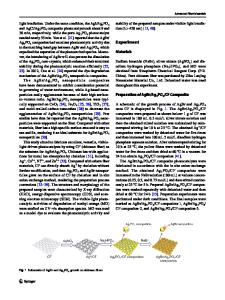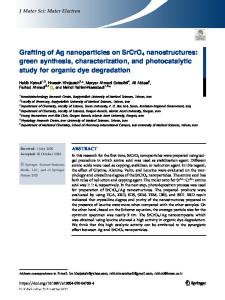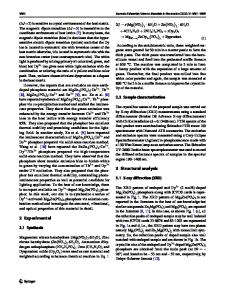Study on the synthesis and photocatalysis of Ag 3 PO 4 polyhedral microcrystals
- PDF / 546,409 Bytes
- 5 Pages / 595.276 x 790.866 pts Page_size
- 63 Downloads / 257 Views
Bull Mater Sci (2020) 43:223 https://doi.org/10.1007/s12034-020-02190-8
Sadhana(0123456789().,-volV)FT3](012345 6789().,-volV)
Study on the synthesis and photocatalysis of Ag3PO4 polyhedral microcrystals TAO GENG1,2,*, SHUANGBIN ZHANG1,2 and YAO CHEN1 1
School of Chemistry and Chemical Engineering, Suzhou University, Suzhou 234000, People’s Republic of China Key Laboratory of Spin Electron and Nanomaterials of Anhui Higher Education Institute, Suzhou 234000, People’s Republic of China *Author for correspondence ([email protected]) 2
MS received 22 December 2019; accepted 11 March 2020 Abstract. The silver phosphate (Ag3PO4) sample was synthesized using Na3PO4, AgNO3 and PEG-10000 as raw materials by the hydrothermal method. Its different morphologies were obtained by changing temperature and surfactant. And its structures and morphology were characterized by X-ray diffraction and field emission scanning electron microscopy. The result of the study indicated that after the heat treatment at 150°C, the as-obtained Ag3PO4 polyhedral microcrystal’s diameter was about 4 lm. Meanwhile, it showed that using Ag3PO4 polyhedral microcrystals as photocatalysts, the photocatalytic degradation rate of methylene blue in aqueous solution was close to 98.5% after 25 min of sunlight. Keywords.
1.
Photocatalysis; Ag3PO4; hydrothermal method; methylene blue.
Introduction
With the rapid development of industrial production, the environmental pollution is getting worse and worse day by day. Especially the more and more organic pollutant in wastewater brought by the printing and dyeing industry makes our living environment increasingly deteriorating [1–4]. In fact, it is threatening our existence. Therefore, it will be of great significance to effectively deal with wastewater organic pollutant which is produced by the printing and dyeing industry, then impose on environmental protection and improve the quality of water circumstances [5]. Photocatalysis, as a green technology, aided by photocatalysts, is widely used to catalyse the degradation of organic pollutants under the light. Among semiconductor photocatalysts, the Ag3PO4 sample is a hit subject due to its obvious advantage that it can absorb sunlight at wavelengths less than 520 nm and under the irradiation of light shows a strong oxidation capacity [6]. Ag3PO4 as is a narrow band gap semiconductor, a visible light novel photocatalyst with an indirect band gap of 2.36 eV, under visible light irradiation, the electrons in the valence band (VB) of Ag3PO4 were excited to conduction band (CB) to generate electron–hole pairs [7]. Furthermore, reactive holes at VB are able to oxidize organic dye pollutants directly to CO2 and H2O because of its intense oxidation. In 2010, Ye and his co-workers [8] discovered Ag3PO4 as a new and meaningful photocatalyst, and furthermore found that it has extremely high efficiency for degradation organic
dyes in visible light irradiation. It is well known that the properties of nanomaterials are greatly affected by the morphology, structure and phase
Data Loading...










